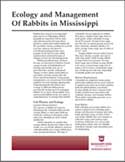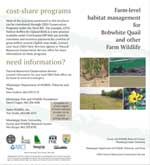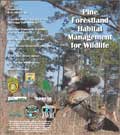Game Animals
Non-game Animals
Habitat
Eastern Cottontail Rabbit
Sylvilagus floridanus
- One of the most commonly found mammals in U.S.
- found in open grassy fields and dense growth along fields and woodland edges
- industrialized farming and forestry, removal of non-native plants, and invasive grasses contribute to habitat decline
Species Description: Eastern Cottontail Rabbit
The eastern cottontail rabbit is a popular game animal and one of the most commonly found mammals in the United States. Their habitats consist of open grassy fields and dense growth along fields and woodland edges. Within the last 30 years, their population has declined because of changes in land use.
These rabbits have high mortality, with a death rate up to 80 percent per year. Their main predators are domestic dogs and cats, coyotes, bobcats, hawks and owls. Other causes of death include inclement weather, vehicle collisions and disease. Industrialized farming and forestry, removal of non-native plants, and invasive grasses have also contributed to the decline in rabbit populations.
The species survives because they reproduce up to seven times per season. For successful reproduction, the cottontails’ habitats must be in close proximity to one another. Eastern cottontail rabbits do not travel far and usually spend their lives in an area no larger than 10 acres. A small area with open fields for foraging and plenty of edge brush for nesting provide the most ideal habitat. Proper maintenance of these types of habitats allow eastern cottontail rabbits to thrive.

The Ecology and Management of Rabbits in Mississippi (PDF)
Mississippi State University Extension Service
Two rabbit species can be found in Mississippi: the cottontail rabbit and the swamp rabbit. The life history and ecology, habitat requirements, food habits, breeding and mortality, and reproductive cycle of each are discussed. Specific habitat management practices for fields and grasslands and forests include the planting of native warm-season grasses, disking, prescribed burns, supplemental food plantings, herbicide treatments, and creating shrub cover or brush piles.

Farm-level Habitat Management for Bobwhite Quail and Other Farm Wildlife (PDF)
MSU Forest and Wildlife Research Center
Practices that agricultural producers can use to increase or improve wildlife habitat on their lands are discussed in this brochure. A brief discussion of managing vegetative buffers, grassland habitat, and woodlands for wildlife habitat is given as well as a mention of the cost-share programs available.

Pine Forestland Habitat Management for Wildlife (PDF)
Mississippi State University Forest and Wildlife Research Center
Pine forests can be managed to provide wildlife habitat using a variety of techniques, some of which can improve timber stand quality. Established stands can be managed with thinning, prescribed fire or disking, and even herbicide control of hardwoods which can provide food and cover for quail and grassland species, deer, rabbits, turkey and other wildlife. Regenerating stands can be managed to provide weeds, legumes, and grasses that benefit quail and other early successional wildlife species. Even former agricultural fields can be managed for grassland habitat in conjunction with pine production to include wildlife habitat.
Blackberry, switch cane, and crossvine are components of excellent rabbit habitat in the floodplain. They use the plants for cover, food, and nesting. Birds, butterflies, and bees also feed on the nectar from flowers and many birds and mammals eat berries of the blackberry plant
Partridge pea is an annual plant that is native to Mississippi and attracts birds, butterfly, and rabbits. It is an excellent wildlife plant, especially for bobwhite quail.

